It's not unusual to have this kind of question debated in tech forums, so today we're having a look at the performance impact of having four DDR4 memory modules in a dual-channel system, opposed to just two modules. In this scenario all modules are operating at the same frequency, use the same timings, and provide the same total memory capacity.
Dual-channel platforms such as AMD's AM4 or Intel's LGA1151 require two matched memory modules for dual-channel operation, adding a second pair will only expand memory capacity and won't upgrade you to quad-channel memory, for that you'd need a Threadripper or Cascade Lake-X processor.
However, we've seen tests around showing an increase in performance by adding two extra modules, allegedly without increasing memory frequency, or improving timings.
We believe this due to how the memory is configured or more precisely, the memory 'rank'. For those of you unaware, the term 'rank' means the number of 64-bit memory banks on a module. Most consumer grade memory features a single rank, though higher capacity modules are usually dual rank, while server grade memory is often quad-rank.
Identifying if your memory is dual or single rank can be difficult as software doesn't always read modules correctly and not all memory manufacturers note the rank in the modules' ID.
Typically, single rank modules feature all memory chips on one side of the PCB, while dual rank memory places chips on both sides of the PCB. However, that's not always the case. A module with chips on both sides of the PCB is just dual-sided, and can still be a single-ranked module, so it's a bit confusing.
Things get even messier when you introduce more memory sticks or modules. A system populated with more than two single-ranked modules will actually act as if dual-ranked modules are installed. In fact, there is very little difference between one dual-ranked module and two single-rank modules when connected to the same memory controller, even though the memory chips reside on different PCBs.
This is important to note because in the tests we've seen all memory used has been single-ranked modules. So when using two single ranked modules for dual-channel operation, the memory is configured as a single rank. However, when using four single rank modules for dual-channel operation, the memory is now configured as a dual-rank.
DIMM Module Rank Configurations
This can give the four DIMM module configuration an advantage as it allows several open DRAM pages in each rank. Although the ranks can't be accessed simultaneously, they can be accessed independently and this means the controller can send write data to one rank, while it waits for read data previously selected from another rank.
How much of an impact this has on performance depends on the application and the memory controller's ability to take advantage of open pages. But what all this means is, yes it's possible for four modules to improve performance over two modules in a dual-channel system.
Demonstrating that we'll look at a series of benchmarks conducted using a Core i9-9900K and Ryzen 9 3900X processor. Supporting this investigation is Team Group with their T-Force Vulcan Z DDR4-3000 memory. They've provided two 8GB modules along with four 4GB modules, all using the same timings.
Tests on the Intel system mostly took place on the Gigabyte Z390 Aorus Ultra motherboard, but we've also included some testing on a cheap MSI B360 board. Then for the Ryzen test system we have the Gigabyte X570 Aorus Master, both using an RTX 2080 Ti to reduce GPU bottlenecks in our tests.
Benchmarks
First up we have Call of Duty: Modern Warfare where we see no discernible difference between 2 and 4 RAM modules, for both AMD and Intel dual-channel platforms. This is probably the kind of performance you'd expect to see for the most part, but it's not always the case.
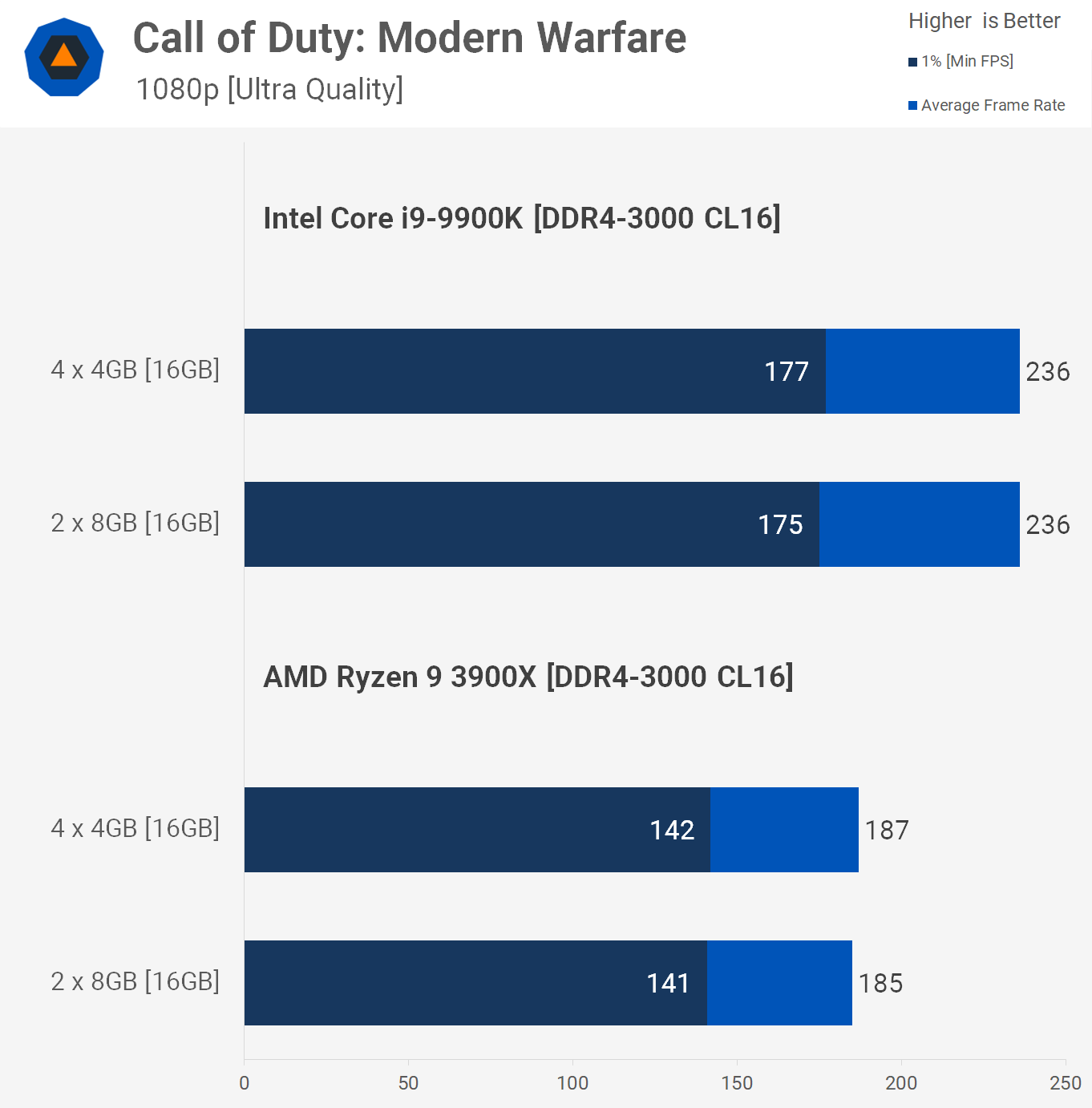
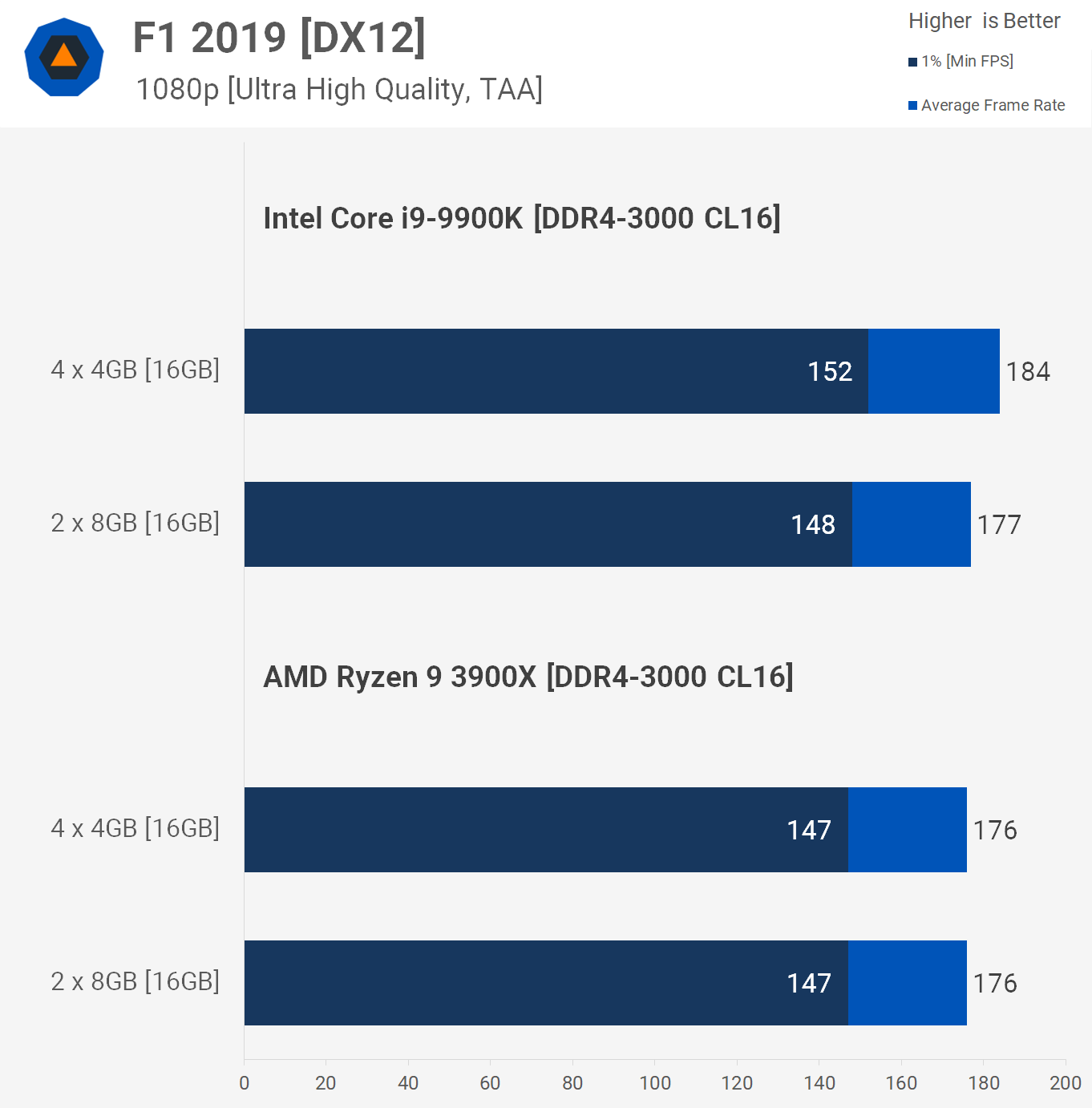
Here is an example where we do see some difference in performance for the Core i9-9900K, but not the Ryzen 9 3900X. The Intel system saw a mild 4% performance boost when using four memory modules and this was replicated several times.

It's a similar story with Shadow of the Tomb Raider. The Intel system saw up to a 4% performance boost, certainly not massive, but it was a difference that we could reproduce over and over. On Ryzen it didn't matter, two or four modules produced the same result.
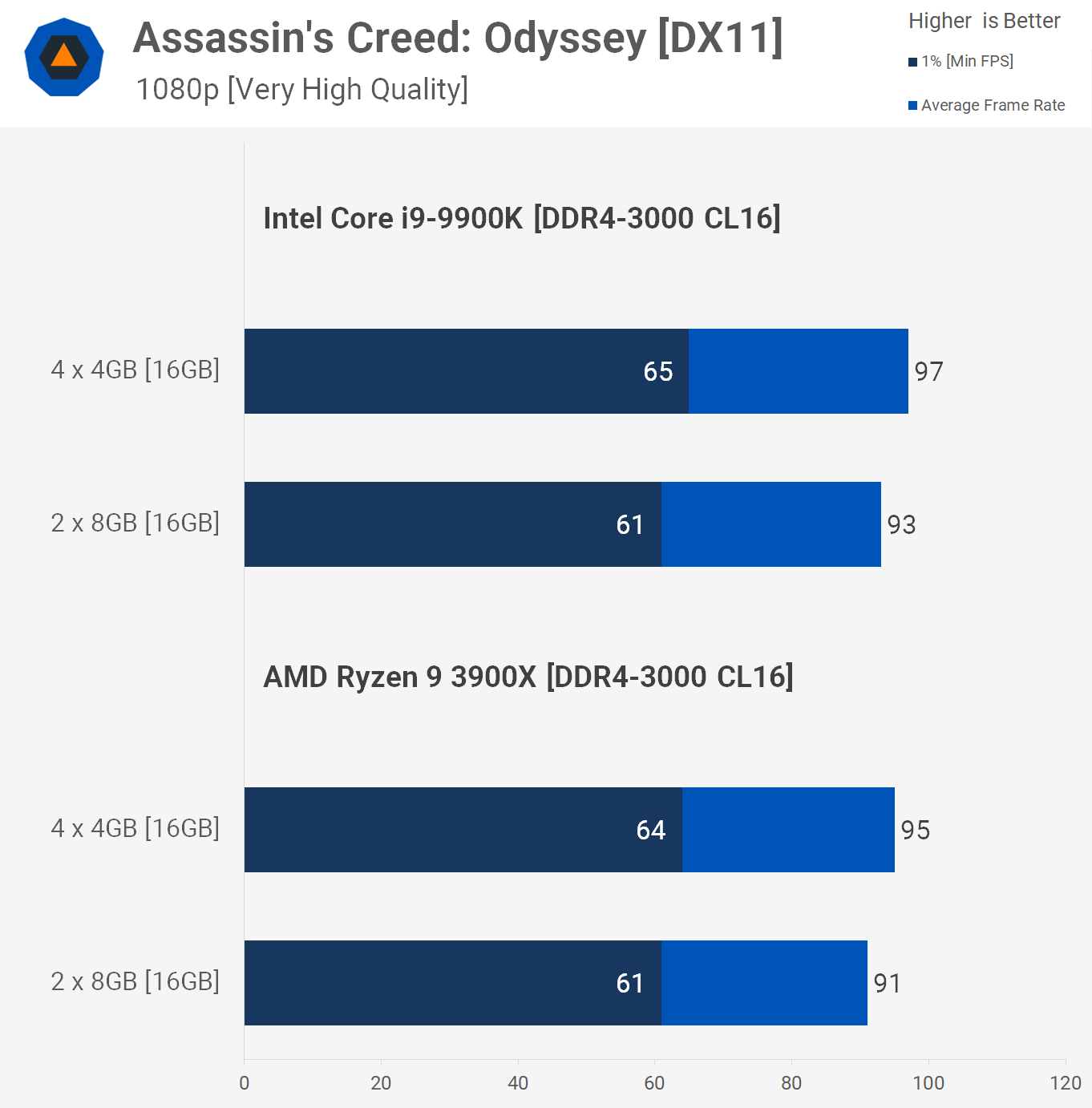
Testing with Assassin's Creed Odyssey was interesting, we saw gains for both AMD and Intel when using four memory modules. The Core i9-9900K's performance was boosted by up to 7%, and 5% for the Ryzen 9 3900X. Clearly dual-ranked memory is of benefit in this title, at least under these conditions.
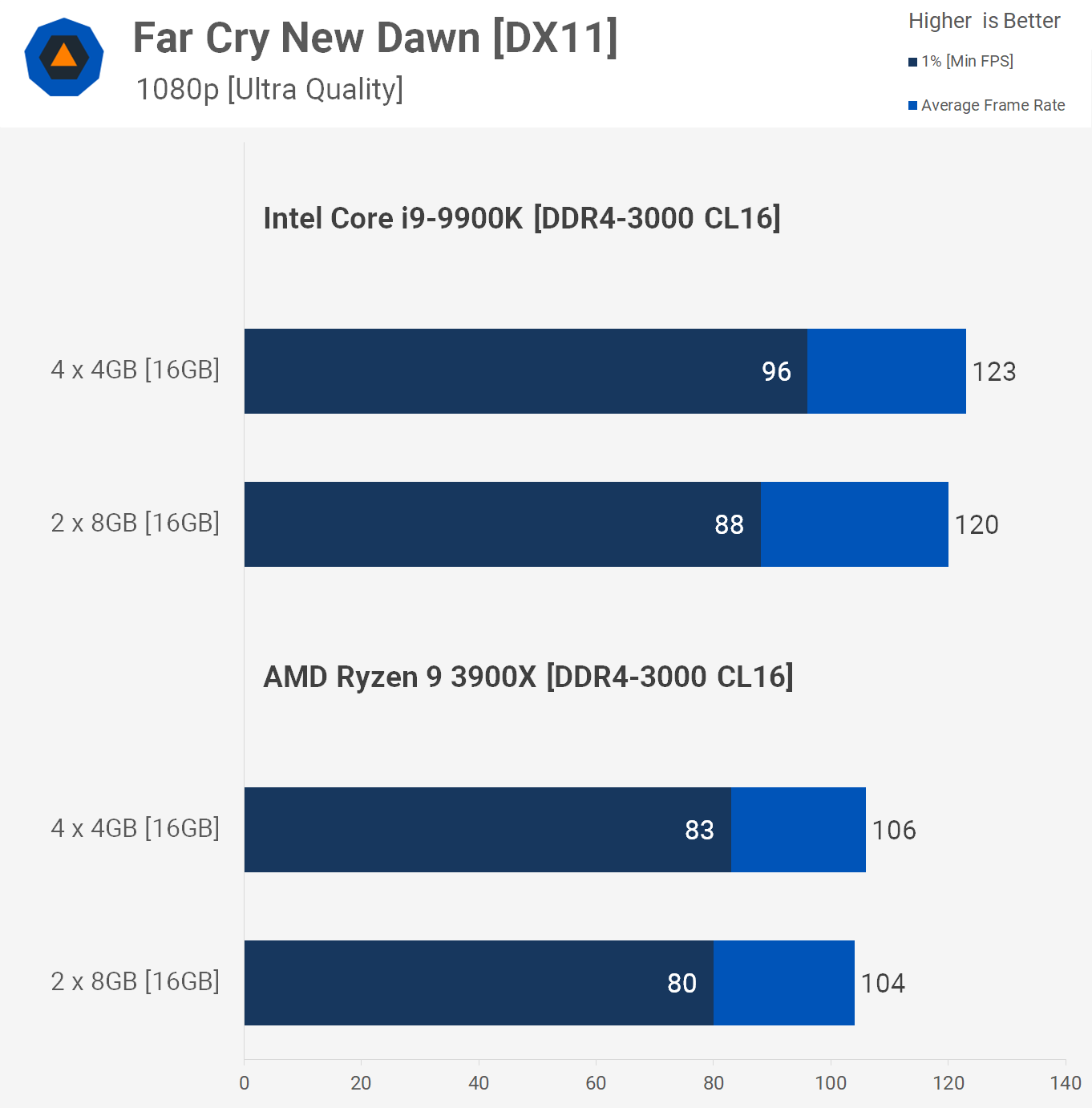
An impressive 1% low performance result in Far Cry New Dawn with the 9900K. Performance was boosted by 9% and although the average frame rate is barely improved, it's still possible you'd notice the increased 1% low frame rate. The Ryzen 9 3900X system was consistently a few frames faster with 4 RAM modules, but not to the degree where you'd notice a difference.
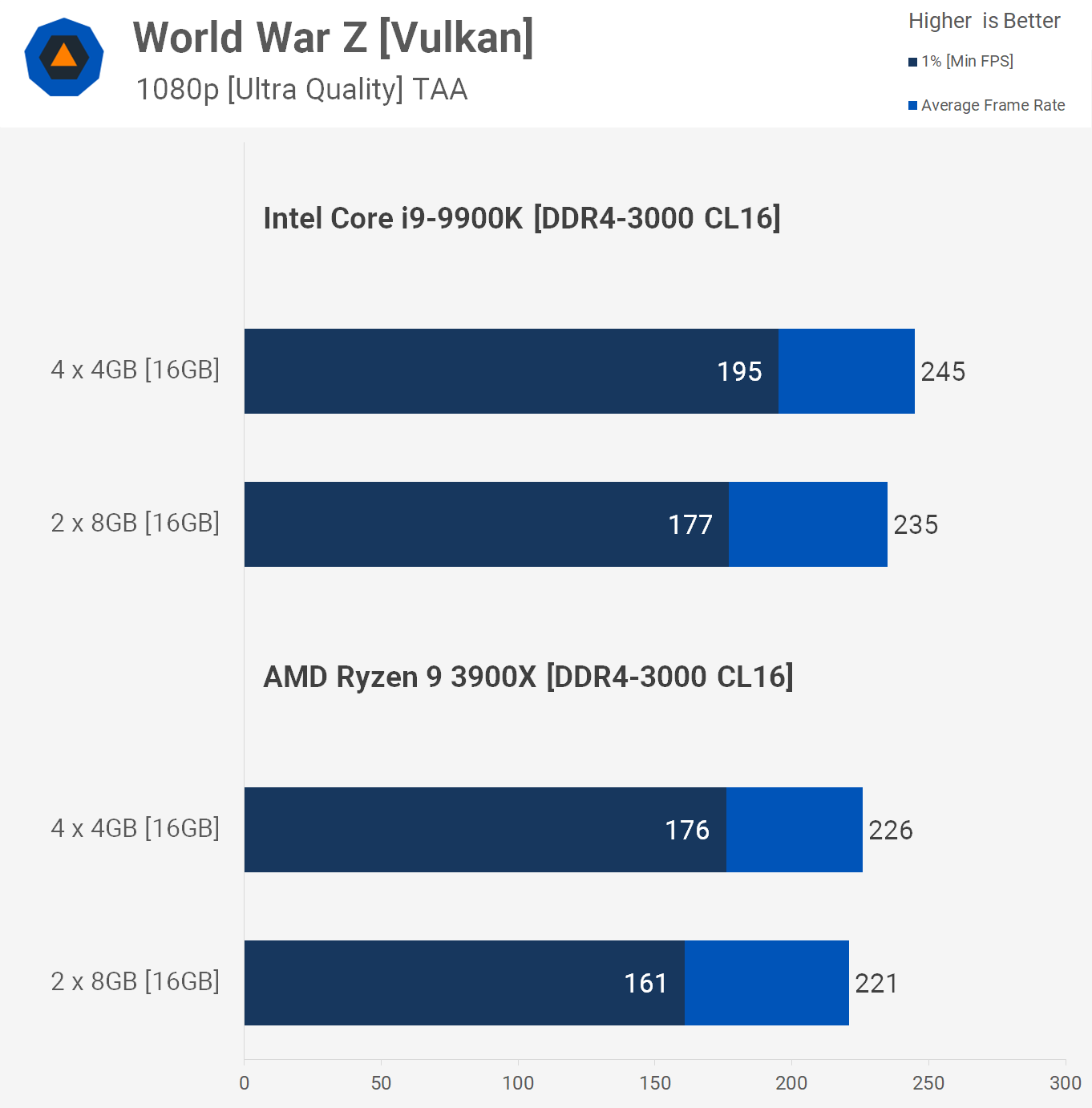
The performance gains seen when fully populating the DIMM slots in World War Z are quite impressive, here the 9900K was up to 10% faster, while the 3900X was up to 9% faster. Those are fairly significant gains, though we are pushing well over 150 fps here.

We've re-tested a B360 board with the 9900K installed and we're comparing the World War Z results. Of course, we're limited to DDR4-2666 on the locked chipset, but the point was to see if four modules still boosted performance on a budget board and as you can see here, they do as we're looking at up to a 6% performance increase. The margin isn't quite as significant but we're also running the memory at a lower frequency now.
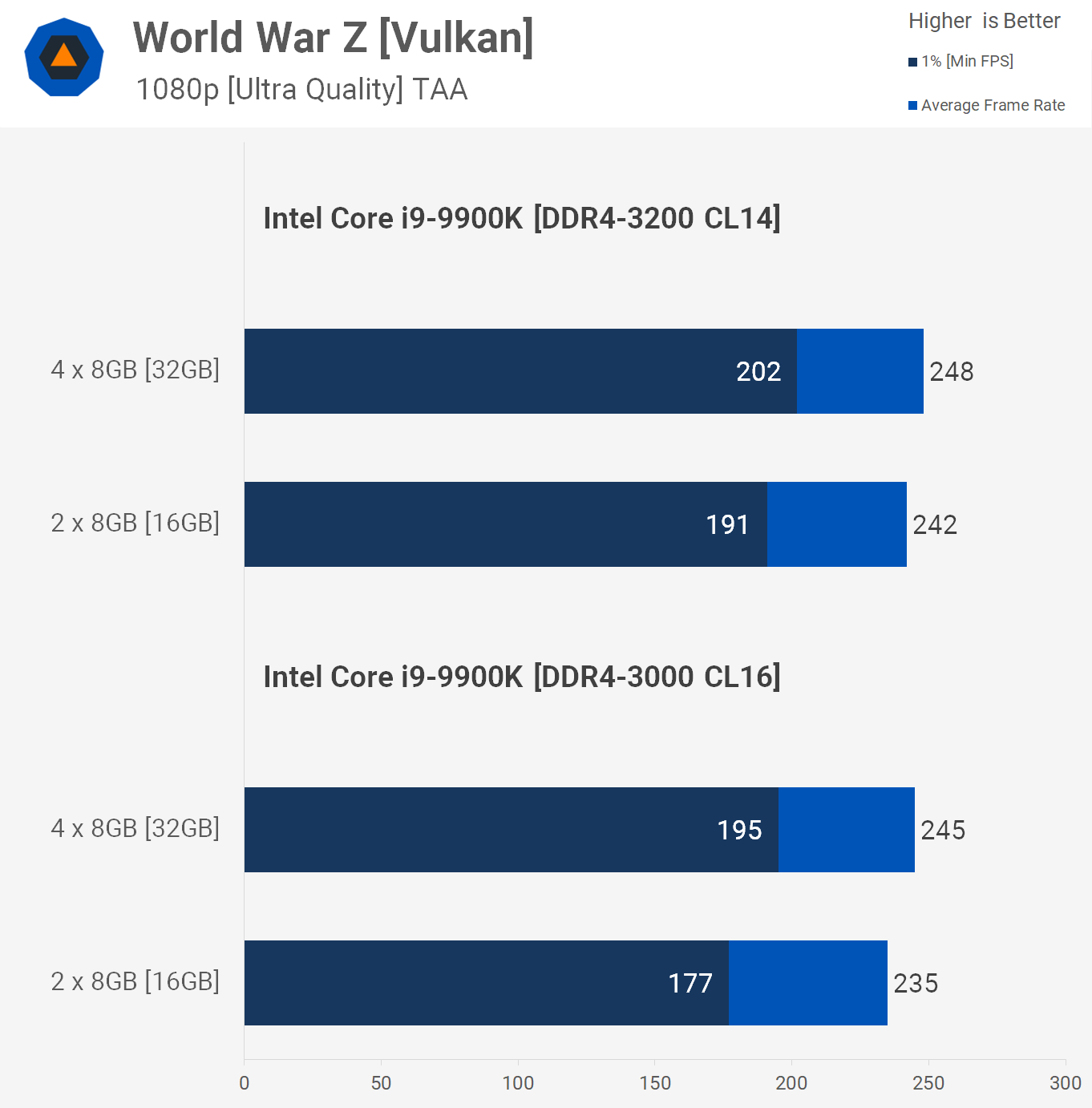
And just lastly here's a look at how the DDR4-3000 CL16 memory compares to DDR4-3200 CL14 memory. Please note the CL14 memory does pack a 32GB capacity as you can't get 3200 CL14 4GB modules, but since World War Z doesn't require more than 16GB of memory, this won't impact performance.
What we suspect we're seeing here with the faster memory is the Core i9-9900K starting to reach the limits of the RTX 2080 Ti under these test conditions. Whereas previously with the DDR4-3000 memory the 9900K saw a 10% boost with four modules, that margin has been reduced to 6% with the faster memory.
Wrap Up
Installing four memory modules in a dual-channel system can improve performance in certain scenarios. However it should be made clear that this won't automatically translate into a 5-7% performance boost in games. For that to occur you need to be more CPU limited than GPU limited and that's rarely the case when using good graphics quality settings or hardware configurations.
For example, we were testing with a GeForce RTX 2080 Ti at 1080p. Increasing the resolution to 1440p will likely result in neutralizing any benefit we just saw with the two extra modules as games become predominantly GPU bound. The same would be true at 1080p using a lesser graphics card.
It's also worth noting that four modules can also limit memory performance in the sense that you might not be able to achieve the same frequency and timings that you could with just two modules. In other words, a straight comparison becomes quite difficult to make as there are a number of variables that need to be considered.
The Ryzen 9 3900X is limited to DDR4-2933 when using four modules, whereas AMD's official spec says the CPU will handle DDR4-3200 with just two modules. Depending on how good the silicon is, the integrated memory controller might do better than that. Our chip handles right up to DDR4-3600 CL16 memory with four modules, but whatever the limit, the point is, it will go higher with just two modules.
Dual-ranked modules introduce a new set of limits, though none were explored in this article. AMD lists the official dual-ranked DIMM support as DDR4-3200 for two modules, but just DDR4-2666 when using four modules. It would be interesting to see how two and four dual-ranked modules compare in these dual-channel systems, but that's a test for another day.




